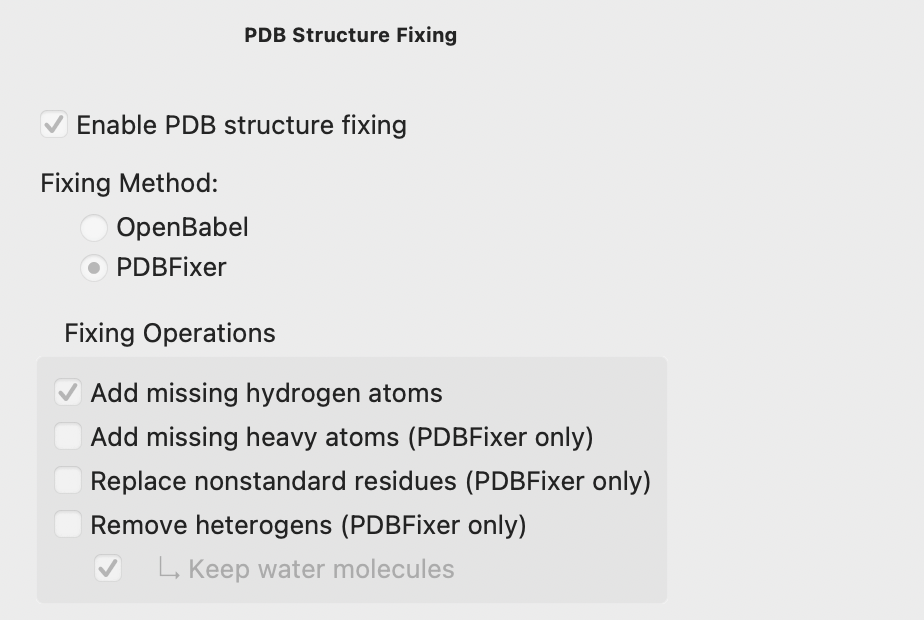PDB Structure Fixing#
This document provides details about HBAT’s PDB fixing capabilities, which can automatically enhance protein structures by adding missing atoms, converting residues, and cleaning up structural issues.
Overview#
HBAT includes integrated PDB structure fixing capabilities that can significantly improve the quality of structural analysis by:
Adding missing hydrogen atoms using OpenBabel or PDBFixer
Adding missing heavy atoms using PDBFixer
Converting non-standard residues to standard equivalents
Removing unwanted heterogens while optionally keeping water molecules
Improving structure quality for more accurate interaction analysis
These capabilities are particularly valuable when working with:
Crystal structures missing hydrogen atoms
Low-resolution structures with incomplete side chains
NMR structures requiring standardization
Structures containing non-standard amino acid residues
Structures with unwanted ligands or contaminants
Why PDB Fixing is Important#
Most PDB structures from X-ray crystallography lack hydrogen atoms because they are too small to be reliably determined at typical resolutions. Since hydrogen bonds are critical for:
Protein stability: Secondary and tertiary structure maintenance
Enzyme catalysis: Active site interactions and mechanism
Protein-protein interactions: Interface stabilization
Ligand binding: Drug-target interactions
Accurate hydrogen placement is essential for meaningful interaction analysis.
Supported Methods#
HBAT supports two powerful methods for structure enhancement: PDBFixer and OpenBabel.
Capability |
OpenBabel |
PDBFixer |
|---|---|---|
Add hydrogens |
✓ Fast and reliable |
✓ pH-dependent protonation |
Add heavy atoms |
✗ Not supported |
✓ Complete missing atoms |
Convert residues |
✗ Limited |
✓ Comprehensive database |
Remove heterogens |
✗ Not supported |
✓ Selective removal |
Speed |
Very fast |
Moderate |
Dependencies |
Lightweight |
Requires OpenMM |
Documentation |
PDB Fixing Parameters#
HBAT provides comprehensive control over structure fixing through various parameters:
Core Parameters#
Parameter |
Default |
Type |
Description |
|---|---|---|---|
|
True |
Boolean |
Enable/disable PDB structure fixing |
|
“pdbfixer” |
String |
Method to use: “openbabel” or “pdbfixer” |
|
True |
Boolean |
Add missing hydrogen atoms |
|
False |
Boolean |
Add missing heavy atoms (PDBFixer only) |
|
False |
Boolean |
Convert non-standard residues (PDBFixer only) |
|
False |
Boolean |
Remove unwanted heterogens (PDBFixer only) |
|
True |
Boolean |
Keep water molecules when removing heterogens |

Advanced Parameters#
For PDBFixer, additional options are available but there are not supported by HBAT yet.
Parameter |
Default |
Description |
|---|---|---|
|
7.0 |
pH value for protonation state determination |
|
False |
Add missing residues to complete chains |
|
True |
Preserve original atom numbering |
References and Further Reading#
OpenBabel#
O’Boyle, N.M. et al. “Open Babel: An open chemical toolbox” J. Cheminform. 3, 33 (2011)
OpenBabel Documentation: http://openbabel.org/docs/
PDBFixer#
Eastman, P. et al. “OpenMM 4: A Reusable, Extensible, Hardware Independent Library” J. Chem. Theory Comput. 9, 461-469 (2013)
PDBFixer Documentation: openmm/pdbfixer
PDBFixer Wheel: https://pypi.org/project/pdbfixer-wheel/
For questions about PDB fixing functionality or specific use cases, please refer to the HBAT documentation or open an issue on the GitHub repository.